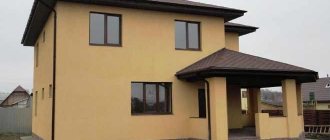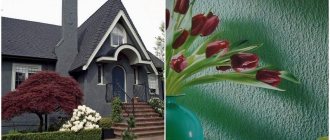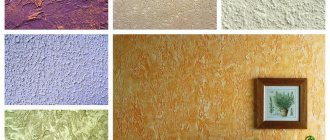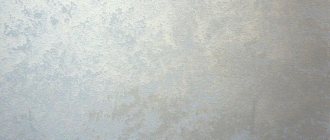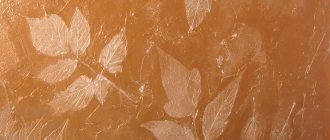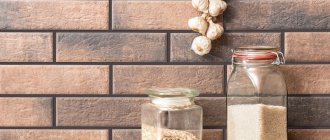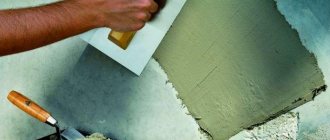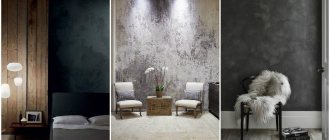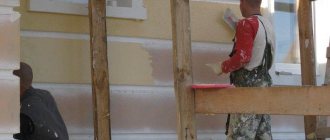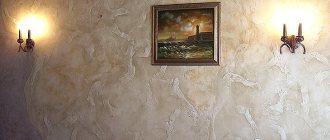People have been able to give various surfaces a stone-like appearance since ancient times. In his description of the restoration of the burnt Winter Palace, Bashutsky mentions the marble-like plaster used in the royal mansions. Petersburg was built quickly, even royalty lived in palaces decorated with “fake” marble and granite. Stone-look surfaces are especially popular today. They are monumental, diverse, interesting in the interior and landscape of any style. Do-it-yourself decorative plaster to look like stone is a task that can be easily accomplished even for beginners.
Imitation methods
There are many ways to create a rock-like surface.
The main ones in application are:
- use of hanging plastic panels for wall decoration,
- wall cladding with gypsum or cement relief tiles,
- creating a dummy cover from foam plastic,
- formation of masonry or decorative layer from mortar.
Stone decor with an individual design can be created using plaster mortars (in the old-fashioned way, stucco).
Imitation of stone on the wall - torn rock, masonry, processed solid marble, malachite, sandstone or granite - is created using artistic methods or using various prints. Different techniques for simulating stone textures provide different depths of elaboration of the design.
The following techniques exist:
- flat with a coating layer thickness close to 1 mm (Venetian plaster),
- textured, having a rough surface (decorative travertine plaster, sand plaster, marble plaster, etc.),
- flat-relief in which the seams of the masonry are barely deepened,
- convex in the form of three-dimensional masonry, otherwise called 3d.
Scope of application of gypsum tiles
A large selection of shades and textures of gypsum tiles allows you to use them as a decorative element in residential premises, clubs, hotels and restaurants. This material will look harmonious in an elegant interior decorated in Baroque or Rococo style, and will perfectly complement Provence or country.
Panels lined with artificial stone will give the room a resemblance to chambers in a Gothic castle, and a “brick” fireplace will soften the strict lines of a high-tech room.
Relief gypsum tiles hide defects and unevenness of load-bearing surfaces and corners well. It is used to decorate slopes, door and window openings, arches, and bay windows.
Columns lined with material with an interesting texture look elegant and bring a festive touch to the interior. It looks beautiful both as a wall made entirely of masonry, and in combination with wallpaper. Finishing with gypsum tiles is an excellent solution for giving the interior of your home a rich and attractive look, and you can choose the color and relief options according to your own desire and taste.
Main components of the plaster composition
Decorative coating with a stone appearance is made using plaster mortar.
It, like other plaster solutions, contains:
- Binders – acrylic resins, cement, silicate (organosilicon), gypsum, silicone resins, lime;
- Fillers – calibrated stone chips and/or flour of various rocks, quartz sand;
- Dyes – mineral, synthetic or organic pigments;
- Plasticizers – PVA, soap solution, soap naft, etc.;
- Additives to impart the desired properties, for example, frost resistance, resistance to fungus, mold, accelerated or delayed setting of binders (soap, animal glue), increased water resistance, greater decorativeness (mica chips, mother of pearl).
If you wish, you can purchase a ready-to-use composition, or you can create a mixture and prepare the plaster yourself.
Types of plaster
According to the type of binding “agent”, the composition can be mineral (lime), polymer (acrylic), silicate and silicone.
Types of plaster:
- Mineral coating mainly contains a lime component, which contains mineral particles, stone chips, colored clay, etc. The obvious advantage of such a coating is that over time the stability of the material only increases. It has excellent resistance to solar UV radiation and steam. Therefore, the composition is often used in damp areas. The main disadvantages of this coating are high cost, low elasticity and poor adhesion to the base.
- Polymer (acrylic) plaster is made using a binder material of acrylic resins. It is resistant to sunlight, temperature fluctuations and moisture. The coating fits well on all types of floors. But it should be noted that the material is vapor-proof. Therefore, it is not recommended to use it in external wall insulation systems.
- Silicate plaster. Its basis is organic silicon. The advantages of the material are vapor permeability, good ductility, resistance to contamination. The downside is the small selection of colors.
- Silicone (siloxane) plaster. The binder in it is silicone resin. It combines almost all the advantages of the above types. It is vapor-tight, hydrophobic, resistant to aggressive environments and ultraviolet rays. A wide range of colors of this material is produced. Due to its good ductility, this plaster is used to create relief patterns. The only negative factor is the relative high cost of this coating.
You can add DIY wall art almost anywhere, from the front of the house to the kitchen divider. For external work, as a rule, rough construction materials are used on a lime binder. Thanks to special modifiers, the plaster does not deteriorate when interacting with water, so even strong moisture is not a problem.
Preparation of the composition
If the decorative mixture is purchased in a store in dry form, it must be diluted with water. Pour the composition into a container with water (¼ volume of dry matter) and then mix it with a drill with an attachment. This must be done exactly according to the instructions. The finished mixture should have a uniform consistency without foreign inclusions or lumps. After a ten-minute break, the mixture is stirred again. It should be so thick that it does not spread when applying a layer and is easy to apply. Immediately after the second stirring, the mixture is ready for use.
How to make liquid wallpaper with your own hands
You can make the product for finishing the room yourself. To do this, use available materials:
- clean paper or waste paper;
- sawdust;
- ecowool;
- pieces of yarn;
- tinsel.
Such mixtures are cheaper than factory ones, although some components need to be purchased.
Instructions for making liquid wallpaper at home
The manufacturing processes of the finishing material differ depending on the selected base material.
Option one - paper waste
Waste paper is the most accessible basis for creating homemade and inexpensive liquid wallpaper from improvised materials. Discarded paper has no value but is a source of cellulose for the finishing mixture. They choose notebook sheets, children's coloring books, newspapers, old paper wallpaper. The pages of glossy magazines are not suitable for these purposes, as they do not dissolve well in water. Thick paper and cardboard are also not suitable.
The sequence of actions when producing a finishing mixture from paper waste:
- The paper is shredded (cut, torn, using a special shredder).
- Fill with warm water in a ratio of 1:5.
- Leave for 12 hours.
- Make a homogeneous mass from paper and water using a construction mixer or drill with a special attachment. The mixture of paper and water turns out gray. The preparation of such liquid wallpaper is the cheapest existing technology. To obtain a white mass, use clean paper.
- Finely chopped cotton wool is added to the resulting mixture and mixed, the volume ratio is maintained at 4:1. At this stage, they no longer use a mixer; they mix by hand. Instead of cotton wool, it is allowed to use synthetic winterizer or other similar material.
- Add small pieces of wool threads of any color in an amount of 1/8 of the total mass.
- Sprinkle glitter, pieces of tinsel, and mica. The amount of decorative additives should be no more than 200 g per kilogram of paper. Manufacturers may vary the proportions slightly.
- Add liquid PVA glue in an amount of approximately ½ of the original amount of paper. It is acceptable to use CMC glue in dry form. You will need 200 g per 1 kg of paper. Glue is the binding component. If it is added dry, a little more water will be needed.
- Coloring agents are added. Its quantity depends on the desired color. The color can be mixed evenly into the mass or left in the form of inclusions and spots to obtain volumetric color transitions. The manufacturer himself determines the intensity of future wall painting. The dye chosen is intended for water-based paint.
- The mixture is placed in a plastic bag. If it turns out too thick, you can add water. The material can be used after 12 hours; it can be stored for about a week. After aging, the mixture acquires a homogeneous consistency.
- Before applying the wallpaper, add gypsum to the mixture (0.5 kg per 1 kg of paper) and mix thoroughly.
If you use waste paper for the base, you won’t be able to get a bright color for the coating. These materials will produce a muted or dark color. Rich colors are obtained by using pure white paper, the purchase of which involves additional costs.
The structure of the future coating can be changed by adjusting the size of the paper grinding. The smaller the pieces, the smaller and more inconspicuous the relief will be. If you cut the paper larger, you can create the effect of river pebbles.
Recipe for making finishing material from paper
Approximate composition of liquid wallpaper and ratio of mixture components:
- paper - 1 kg;
- water - 5–6 liters;
- cotton wool - 250 g;
- wool threads - 100 g;
- PVA glue - 400 ml or dry CMC glue - 200 g;
- glitter and other decor - 200 g;
- dye - from 2 caps;
- gypsum - 500 g.
Option two - use of fibrous materials
Making liquid wallpaper from other materials with your own hands is a more labor-intensive process. Working with cotton wool or ecowool is more difficult than working with paper. If you need to decorate a small area, then the fibrous material is cut with scissors. To renovate an entire room you will need a lot of material; you should grind it with a drill with a mixer attachment.
In addition to cotton wool, to make the finishing mixture you will need:
- Glue (wallpaper glue based on natural casein, PVA, bustylate) as a binding component.
- Acrylic putty to impart wear resistance to the coating.
- Dye.
- Decorative elements.
To prepare such liquid wallpaper at home:
- Grind the base.
- Fill it with the selected binder in a 1:1 ratio and mix.
- Add the required amount of dye and decorative elements and mix thoroughly.
- Leave for 8 hours to soak.
- Before application, putty is added to the mixture.
Cellulose fibers can be replaced with wool, linen, or padding polyester. An additional component can be leftover knitting yarn, as well as old knitted socks and sweaters. It is recommended to chop yarn and threads with a cabbage knife.
How to make wallpaper from sawdust?
Liquid wallpaper is also used from waste from the woodworking industry; its production is possible at home. Small sawdust is suitable for this purpose.
The ratio of components of the sawdust finishing mixture:
- 1 kg sawdust.
- 5 liters of water.
- 500 g glue.
- 500 g of gypsum.
- Dye.
- Antiseptic additive.
- Sawdust is poured with warm water and left for 4–6 hours to soak.
- Add all remaining ingredients except gypsum and leave for 12 hours.
- Add gypsum and begin applying the mixture.
You should not neglect the recipe and add an excessive amount of glitter and other decorative components - this will ruin the structure of the wallpaper.
How to prepare decorative compositions yourself
You can save money by not purchasing expensive ready-made materials. A few simple recipes from a variety of ingredients that you can prepare yourself:
- By adding clean sand, you create decorative plaster with your own hands from ordinary putty. To do this, take 1.5-2 liter buckets of sand onto a putty bucket. The mixture is stirred with an electric mixer. If necessary, add water.
- For exterior work or for finishing wet rooms (bathroom, etc.): 10 kg of lime, 10 kg of cement, 20 kg of sand, enough water to obtain the mass of the required consistency and 5% of the mass of the solution - liquid glass.
- 20% lime paste, 74% marble sand, 5% Portland cement M400 (white), 1% manganese peroxide, the required amount of water.
- 20% lime paste, 6% white cement M400, 4% pigment, 70% quartz sand.
The nuances of preparing stone plaster are as follows:
- mixing water can be running, but should not be below +10 C,
- to get lime paste from dry lime, you need to mix it with warm water 3:1, leave for a day,
- binders can be used in combination, for example, lime with cement, gypsum with lime.
By using homemade formulations, you can significantly reduce costs and create your own wild stone from start to finish.
Step by Step Actions
The process of making stone is quite simple and affordable. Depending on the materials, the technology may differ slightly, but the following algorithm of actions remains unchanged:
- preparation of the workplace and necessary equipment;
- selection and preparation of the form;
- mixing the solution;
- pouring into the mold and distributing the mixture;
- releasing the cast from the mold;
- cleaning the mold;
- grinding, finishing and painting of stone;
- preparing a wall or other area for installation;
- installation of stone slabs;
- finishing of the finished wall.
Artificial stone is a great way to create an exclusive design for the interior or exterior of your home. The wealth of colors and materials leaves room for experimentation and embodiment of your ideas.
Equipment and tools
To perform the job correctly you may need:
- masking tape,
- sanding float,
- steel graters 20 and 25 cm,
- spatulas with rounded edges 6 cm and 20 cm,
- Master OK,
- Maklowitz and Fleitz brushes,
- coarse bristle brush,
- roller,
- rule
- sandpaper No. 120 and 220,
- bubble level,
- tape measure or long ruler,
- containers for solution,
- pencil
- measuring containers or scales,
- electric mixer,
- rags.
Don't forget about personal protective equipment! Gloves, respirator, special. clothes and shoes.
Areas of application of gypsum decorative stone
By artificial we mean an industrially produced product that imitates wild, natural stone. Decorative material is created from gypsum, quartz and colored cement with the addition of polyester resins. Both gypsum and cement stones can include fillers made from natural marble and granite chips. Acrylic stone is also produced (for example, the Tristone brand), which has a rich color palette.
The material is suitable for various substrates: drywall, concrete, brick, wood, plastered surfaces, it is used for interior and exterior work. The most durable finish is quartz. It easily withstands temperature changes, is not susceptible to mold development, is suitable for wet rooms, and is frost-resistant.
The areas of application of decorative stone are varied:
- cladding of stoves, fireplaces;
- finishing of bathrooms, showers, baths, saunas, swimming pools;
- installation of sinks, countertops, bar counters;
- production of window sills, sinks, sanitary products;
- creation of decorative elements and sculptures, stucco moldings, baguettes.
Acrylic stone is often used for repairs in medical institutions and furniture making. The concrete-based material is popular in decorating the facades of buildings and structures; it can also be used for interior decoration, especially in offices and high-traffic areas. Gypsum stone is often used to decorate living rooms, kitchens, and hallways; it gives a cozy look to the apartment. They can also frame mirrors, niches, and headboards. Due to its low mass, gypsum stone is well suited for decorating partitions and ceilings.
Preparing the base
Imitation of stone for interior decoration using plaster requires high-quality execution at any stage. Including in preparing walls for applying plaster.
To ensure that the layer of decorative plaster lays evenly, adheres well and firmly to the base, and subsequently various dirty spots do not appear through the finishing, the surface of the base is prepared:
- it is cleaned of all mechanical contaminants;
- curved walls are leveled by plastering (using cement-sand or gypsum mixture);
- chips and cracks, large excavations are repaired with cement mortar and sand, using reinforcing mesh;
- if necessary, the base is treated with special degreasing or antiseptic agents;
- dried;
- primed for better adhesion (this is a particularly important step for smooth substrates, such as gypsum panels, OSB, fiberboard, etc.).
If the foundation is to be decoratively plastered under a stone, and the foundation/basement of the house is insulated with sheets of foam plastic, then a concrete “crust” is applied and reinforced with two layers of fiberglass mesh. The mesh is applied to a layer of spray 2 cm thick, the second one is placed on top of a spray of the same thickness on the first mesh. A final layer of 2.5-3 cm is thrown over the mesh.
For relief and semi-relief coatings, it is not necessary to level the surface to perfection. This finish will itself hide some imperfections.
Adhesive mixtures "Litokol"
"Litokol" is an excellent manufacturer. Their adhesive mixtures are indeed of high quality. The downside is the high price. But if you still buy this brand of glue, you won’t have to regret your choice. For natural stone, the manufacturer offers the “Litoflex K80” series. This is not the only option; the manufacturer offers several adhesive mixtures for natural stone. Do not skimp on spending your time familiarizing yourself with the line of cement adhesives on the website www.litokol.ru.
Types of stone imitation
Imitating stone from plaster using your own means is done using various techniques. There are more complex and simpler techniques that can be used to achieve a stone-effect finish.
Flat
This type includes decorative finishing finishes, in which the appearance of a polished stone slab is created by using colors on top of the layer or through the components of the finishing composition (multi-colored decorative mortars with stone flour). This is a kind of multi-layer plaster painting. These include Venetian stone plaster. For this purpose, plaster for interior work is used (with marble or other stone flour). To make the surface matte, walls that look like processed marble, onyx, malachite, etc. covered with wax. They are polished to obtain gloss.
Plastering walls to look like stone:
- the base is brought to perfect evenness,
- covered with acrylic putty of a general basic tone,
- apply a decorative layer, doing this in stages (strokes of different colors are applied alternately) or simultaneously (mass of different shades are applied to the edge of the main tool), after which they are stretched along the wall, achieving uneven mixing),
- smooth out uneven surfaces with a trowel after setting begins, achieving maximum flatness of the decorative coating,
- covered with wax,
- polish with a grinder with a soft nozzle.
Textured
These finishes include flat surfaces with small indentations that imitate the appearance of a rough stone surface. The textured finish may have a small decorative pattern or rather convex areas. For example, finishing such as travertine or Roman stone can be done in two ways:
- continuous, in which a uniform layer is formed, decorated after partial drying (using tingling touches of a brush, dishwashing sponge, etc.),
- partial, in which the underlying layer is made even, and the proper one is applied partially (with chaotic strokes), without completely covering the underlying layer.
Textured finishes also include decorative stone finishes that imitate facing with stone slabs or masonry with a shallow depth of grooves applied with a sharp tool.
Flat-relief
The next deepest relief layer elaboration technique is suitable for simulating masonry made of blocks, bricks or flat stone tiles. In this case, the recesses imitating seams do not exceed the thickness of the layer, and the texture of individual blocks is set in very fine relief. An example of such a technique is wood-look plaster performed with special silicone molds, or an imitation of a brick wall, in which decorative stone from ordinary gypsum plaster is obtained by creating a grid of shallow joints.
In the convex technique, the foundation is finished with plaster that imitates cobblestone masonry. In this technique, the relief height is more than 1 cm.
Materials for finishing walls under brickwork
Using real brick in interior design has a lot of disadvantages: labor-intensive masonry, narrowing of space in the room, large load on the floors. Replacing such bricks with facing ones solves almost all these problems, but costs several times more. In addition, facing bricks must be properly cared for, otherwise the appearance of the finish will lose all its attractiveness. But there are other ways to decorate walls, less expensive and very effective.
Polystyrene tiles are an economical material with high thermal conductivity and good sound insulation.
The following materials are used to imitate brickwork:
- ceramic tile,
- wallpaper,
- decorative plaster,
- Styrofoam.
Tiles are ideal for a kitchen or bathroom, but only if you have the skills to install them. This type of cladding is not suitable for a living room, nursery or bedroom, so you should pay attention to other materials. The easiest way to decorate wallpaper to look like brick: there is a huge selection of colors in stores, and the gluing process does not require special skills. But there are also disadvantages here: ordinary paper wallpapers always look dull and cheap, and washable ones look too artificial.
Imitating masonry using decorative plaster is the most profitable option. The cost of consumables is relatively low, the finishing technology is simple and straightforward, and the end result is as realistic as possible. When done well, it is almost impossible to distinguish imitation from real bricks. For greater effect, you can add a coloring pigment to the plaster.
It works well to finish a brick wall using thin polystyrene foam or ceiling tiles. This material is easy to use, light in weight and low in price, so making an imitation of masonry on a wall out of it is not at all difficult. Instead of polystyrene foam or polystyrene, many craftsmen use blanks made of wood, gypsum, and even tile adhesive, but wood requires tools, and gypsum bricks require molds.
Wall finishing with decorative plaster
Regular tile adhesive is suitable for gluing decorative stone.
A quick and convenient way of finishing is applying decorative plaster. The main advantage here is that there is no need to level out minor surface defects, because a layer of plaster will completely hide them. To work you will need:
- primer,
- paint brush or roller,
- gypsum plaster,
- spatula 10 cm wide,
- coloring pigment,
- dry rag,
- small stick.
To form seams in real brickwork, a special jointing tool is used, but for plaster, an ordinary wooden stick, a broken pencil, a ballpoint pen without a refill, or something similar is also suitable, which can be used to draw an even and neat seam. They begin work by preparing the surface: remove the old finish from the wall, seal the cracks in it, clean it of dust and thoroughly prime it. The decoration mixture is prepared after the primer has dried: the dry plaster is diluted with water in the proportions indicated on the package, and then the dye is added. If you plan to paint the walls after finishing, then it is not necessary to add pigment to the plaster.
The thickness of gypsum bricks should be about 5-7 cm.
First, mix a small amount of the composition in order to have time to treat a square meter of surface before the mass hardens. The finished solution should slowly slide off the spatula without forming lumps. If this is the consistency, then you can start applying. Using a spatula or trowel, spread the mortar onto a section of the wall, and then level and slightly smooth the surface. You shouldn’t make it perfectly smooth, because natural brick is rough and sometimes even has small defects.
Now the most important thing is the formation of the brickwork. The sizes of the bricks may be different, but it is desirable that they do not differ too much from the standard ones and the wall looks as realistic as possible. You can draw seams under a ruler, creating a clear pattern, or you can do it arbitrarily, it all depends on the preferences of the master. Lines are drawn along fresh, uncured plaster with a dry stick, creating a pattern of brickwork, and excess mortar is removed with a rag. Then the next section is processed, and so on until the end. After this, the surface must be completely dry, otherwise further processing may damage the pattern.
The dried plaster is sanded with sandpaper to remove excess material and straighten the seams, and then wiped with a dust cloth. Before painting, the decorative masonry is coated with a layer of primer, so the paint adheres much better. If you want to give the finish a more realistic look, then individual bricks can be painted a different color. Sometimes they do it differently: first they cover the wall with a layer of gray plaster, level and smooth the surface well. Then a solution is prepared with the addition of red or brown pigment, it is evenly applied over the previous layer, and then the seams are drawn under the ruler. The red plaster is removed at the joints, resulting in neat bricks separated by gray lines.
Imitation of foam masonry
Tools for preparing the wall surface and installing imitation brickwork.
It’s also not difficult to create decorative bricks with your own hands from polystyrene foam or polystyrene foam. First you need to prepare everything you need for work:
- sheets of polystyrene foam without a pattern,
- felt-tip pen,
- ruler,
- sharp thin knife,
- tile adhesive,
- paint.
At the first stage, it is necessary to mark the sheets of foam plastic: draw even bricks with a side of 7x15 cm under the ruler with a felt-tip pen, making sure to make allowances for the seams. Next, use a knife to cut the foam along the markings and begin preparing the wall.
Image 1. To create roughness and cracks, you can use a drill with drill bits of different diameters.
Remove the old finish, eliminate defects, carefully level the wall and cover it with a primer. A layer of ceramic tile adhesive is applied to a cleaned and dry surface and bricks are placed on it; the gaps between adjacent elements should be about 2 mm. When all the bricks are glued, you can paint the wall, filling the seams well with paint and avoiding drips.
For greater decorativeness, small chaotic indentations and scratches are made on the surface of the foam blanks, which, after painting, give the masonry a slightly worn, but very natural look. The easiest way to create such a texture is with a concave tin strip, which can be cut from an ordinary tin can. Correctly selected colors of dark gray, brown and red add realism. IMAGE 1
Blanks made of gypsum and tile adhesive
This finishing method is in many ways similar to the previous one, but it takes more time to make bricks. For the blanks you will need:
- dry gypsum,
- soap solution,
- paints and brushes,
- pouring form.
For the form, you can use moisture-resistant plywood with a smooth surface. From the outside, the structure is held together with wooden glazing beads, and the seams are necessarily sealed with silicone. Gypsum is mixed with water (to the consistency of sour cream), and then poured into a mold greased with soapy water.
The thickness of the workpieces should be from 0.5 to 2 cm.
The mixture is smoothed with a ruler and left for 20-25 minutes, after which the mold is turned over and the workpiece is removed. After painting, the dried bricks can be mounted on the wall.
Making a brick wall starts from the floor. Using a building level, draw a horizontal line on the wall, then apply tile adhesive with a notched trowel and attach the first row of blanks, trying to make the seams between them the same width. Each subsequent row should be laid in a checkerboard pattern. After laying all the bricks, the seams are filled with plaster and rubbed.
Imitation with prints: description + video
Due to the large surface area that needs to be given the required appearance, decorative facade plaster imitating stone is performed using molds (also known as a matrix). Imitation is carried out according to a template. This is the easiest DIY stone wall decoration.
How to make an imitation:
- apply a layer of plaster to the base,
- moisten the mold with water to prevent the mortar from sticking to its surface,
- press the mold into the freshly laid solution and carefully remove,
- eliminate deformations or minor distortions with a spatula, knife or hand.
Wild stone plaster made in this way has a very realistic appearance. Its manufacture does not require special experience or a lot of time. If a large piece of mortar has been removed along with the form, the mixture is thrown onto the wall again, the form is cleaned, washed and pressed in again.
Features of plastering work
This decorative building material is inexpensive , lightweight, and therefore does not additionally require the use of special power tools for installation. Such plastering can be done by treating not only the outer surface of the facade, walls, but also plinths, fences and even stairs. Use this building material as decoration on any walls.
The technology for applying textured plaster with your own hands can be seen in videos on the Internet, as well as viewing photographs on the pages of magazines and websites. However, the invariable stage of plastering walls, plinths, and facades with your own hands is preparatory work.
As shown in the photo, the old backing is removed from the wall - the remains of the wallpaper are completely removed. If oil paint is difficult to remove, then wash it with soapy water. If there are cracks on the surface, they need to be fixed with a mixture of gypsum or putty .
DIY plaster stone
The technology here is very simple. The only difficulty is the drawing process.
- Prepare the solution
- Apply the solution to the wall - you can apply it by hand, leveling it very roughly
- Use a knife, chisel, palette knife or other suitable tool to create a pattern of masonry
- Go over the resulting seams with a brush to remove tool marks and make the surface natural
- Smooth the surface, give it a natural look by using a sponge or a lint roller.
- Paint the resulting masonry
In addition to the paint itself, to give an interesting texture, you can use colored sand and other bulk mineral components (crumbs of granite, marble, etc.)
Using tools to properly apply adhesive
- When using cement-sand mortar as glue for decorative stone, you will need a wide and narrow spatula. The first is used to apply the solution, and the second is used to remove its excess.
- To apply tile adhesive, use a serrated spatula. And also a narrow and straight spatula to remove excess composition.
- If PVA glue is used, you can use a brush or sponge to apply it; remove any excess with a dry cloth.
What mistakes to avoid
- Various pellets and roughness only spoil the marbled finish, give it a sloppy appearance and give off a completely unprofessional appearance. It is better to remove them during the work process, without delay.
- Artificial stone with its forms does not have to have a perfect appearance, as, for example, in the amazing masonry in Cusco. It is even advisable to make the depressions between the blocks of different widths and depths.
- Walls with brickwork are characterized by a strict horizontal direction of the rows. The same rule is followed when imitating block masonry.
- The plaster, the imitation of stone, can be of any composition. Decorative techniques can make it stone-like. But the shape of cobblestones or blocks must certainly have a natural appearance. Scale relief does not exist in nature or in masonry. This is a gross mistake that should not be made.
As a rule, such work is done with your own hands for yourself, so shortcomings and some mistakes are forgivable.
Walls
Natural stone has been used for aesthetic decoration of houses for a long time. Natural stone has always been very expensive. But today a way out of this situation has been found, which consists in making artificial stone with your own hands based on gypsum. Accordingly, the cost of such material will be lower than the price of natural material.
Content:
Features of artificial stone
The use of natural stone makes it possible to achieve different results when finishing the interiors of buildings. You can decorate the room in a knightly style, and the end result will be a real castle. It will be possible to line the fireplace with slates, which looks very aesthetically pleasing.
For all its advantages, beautiful shapes and colors of natural stone, it also has disadvantages. These include such characteristics as: high cost, heavy weight (not every wall can withstand such a load), considerable transportation costs. In order to use stones in interior decoration and to minimize all the disadvantages written above, a technology for the production of artificial stone was created.
In appearance, there are no special differences between natural and decorative stone. But still, artificial does not have such great disadvantages as natural. There are several options for making decorative material. In the first of them, water, sand and cement are used, in the second - gypsum or alabaster. There is another option when various polymeric substances are used.
Advantages of decorative stone
If you need to choose between natural and artificially created stone, then artificial stone has a number of the following advantages:
- If we consider two externally identical stones, decorative and natural, then the first one will be several times lighter. The low weight of artificial stone makes it possible to cladding thin partitions with it.
- Artificial stone is much easier and simpler to process. It is often made in thin tiles to reduce the weight of the object without any loss of strength. It is also produced at the point of use, eliminating losses during transportation. In addition, it is possible to make an artificial stone from gypsum immediately smooth, which will reduce the significant costs of stone processing - grinding and polishing.
- Decorative stone is not afraid of various atmospheric influences and corrosion, unlike its natural competitor.
- Decoratively finished walls with this material are easy to clean and do not get dirty. However, such a coating is hygroscopic.
- The design of the artificial stone can be arbitrary. We'll talk about its features later.
- Artificial stone has one more advantage compared to natural stone. It has a wide range of colors.
- Thanks to its diversity, decorative stone is suitable for any room. They can be used both indoors and outdoors.
In addition, decorative material can be made as similar as possible to any natural one. According to the type of surface, artificial stone can be:
- Stabbed. In this case, it seems as if the edges have been beaten off with a hammer, that is, an uneven surface is obtained.
- Sawn. The stone has uneven smooth edges.
- Butov. The stones look like natural boulders.
- Arbitrary. The designer realizes all his fantasies in the form of the material.
- Decorative. To bring it to life, other types of surfaces may be required, intended for finishing various ensembles, for example, decorative stones made of gypsum in the style of a marine theme or imitating slate.
Do-it-yourself artificial gypsum stone
Making decorative stone from gypsum is not particularly difficult. Of course, everything may not work out smoothly the first time, but don’t be discouraged.
Thanks to this decoration, your home will be filled with special color, comfort and beauty.
Preparatory work
At the preliminary stage, prepare the following materials and tools for the manufacture of artificial stone:
- White plaster;
- Anhydride;
- Water;
- Sand;
- A plastic container that is needed for mixing various components;
- Pallet;
- Rolled polyethylene;
- Matrices (forms);
- Electric drill;
- Glass is corrugated;
- Water-based coloring compounds.
The production of stone and gypsum does not require huge areas. A few squares will be enough. You should first arrange your workplace with a table. Racks and shelves should be close at hand. Next, we prepare a gypsum solution from elements such as water, gypsum, and anhydride.
Making molds for stone
Remember that you should pay enough attention to the forms for making decorative stone:
- The most optimal and flexible forms are those made of silicone. You can also use forms made of metal, plastic, and wood. But they do not provide a clear texture of the gypsum, that is, they do not reflect the small details of curves and various reliefs.
- Typically, making molds begins with choosing the size of the stone you like. You can pick up a sample for making your own stone in a store.
- To make molds in which artificial stone is cast, prepare silicone and a box of the required size. It should be slightly larger than the sample stone. This box serves as formwork.
- The box and stone should preferably be coated with grease, but other types of lubricants can be used. The stone is placed at the very bottom of the box.
- For better performance, it is necessary to make several forms and forms. With multiple molds, many more stones can be made.
- Next, silicone is poured into the formwork. For better compaction, tamp with a brush, which is moistened with a soap solution. Fairy is used as such a soap solution. After filling the mold with silicone, level the entire surface with a spatula (moistened with Fairy).
- Poured forms dry within a few weeks. After this, the formwork is broken and a sample stone is taken out. The mold for the plaster stone is ready.
- If there are minor defects on the surface, they are repaired using silicone.
- You can also use ready-made silicone models that are commercially available.
Advantages of artificial masonry
The main advantages of this decor are:
- Unlimited possibilities for creating the desired texture and shape,
- Original design,
- Can be applied to any base
- Light finishing weight,
- Fire resistance,
- Ease of manufacture,
- Relatively low cost,
- Long-term operation.
The article provides information on how to make decorative stone plaster in the form of masonry or a marble monolith with your own hands using various techniques. Using simple technologies, you can easily make the wall of your house marble with your own hands, and decorate the base, gazebo or fence to resemble an ancient wall made of cobblestones or granite blocks. The main thing is to start. An exciting activity will make work joyful and your home unique.
Silicone molds
It can be purchased at a hardware store, or you can make it yourself. For this you will need:
- silicone;
- solid base;
- sample stone;
- soap solution;
- a solid box, or other available materials that will serve as formwork;
- solid oil
First you need to install the form. Its edges should be higher in height than the stone. A thick layer of grease should be applied to all internal surfaces of the mold and to the stone samples.
Place stones at the bottom. Pour in silicone. It needs to be leveled with a regular paint brush, and at the very end - with a spatula. The brush and spatula should be moistened in a soapy solution.
The form will dry for 15 days. After this, the box can be disassembled and the finished form taken out.
How does putty differ from plaster?
There are a large number of mixtures with which today you can repair steep surfaces. A beautiful finish is obtained by using decorative plaster. It contains organic components: mineral chips, granite flour, cotton or wood fibers. When they are mixed with a binder, a plastic mass is obtained that easily lays on any base in a thick layer and forms a relief texture. The use of special tools allows you to create more complex patterns. All this significantly expands design possibilities, which has a positive effect on the final result.
Putty is needed to prepare surfaces for subsequent decoration (painting or wallpapering). This is her main task. Plaster helps to form a protective layer; it can be used to correct minor defects and hide unevenness. The composition is applied in a thin layer, no more than one centimeter. It dries quickly, after drying a base appears, which is considered the final stage of repair. Next, the decorating process begins.
Putty helps create a perfectly even base for subsequent decoration. You can work with putty and create a beautiful texture. To do this, you just need to properly prepare the base, prepare the composition of the required consistency, and buy the appropriate tools. The concept of “decorative putty for walls” does not exist. There is only the usual leveling composition and a special technique for applying it.
Secrets of the masters
When carrying out finishing work, each master has his own rules that must be followed.
Let's note the main ones:
- Decorative putty should not be applied to crumbling surfaces or areas with dirt: the material will not stick to them for long.
- A concrete base with oil paint will cause a lot of problems during finishing - it is necessary to wash off the dye.
- If adhesion to a given surface is questionable, use a sickle mesh (it can be glued to the surface using PVA).
- It is undesirable to dilute the composition with a construction mixer: the better the mixture is whipped, the faster it dries.
- Wash off the remnants of each used portion completely: remaining particles of the old composition will cause the new portion to quickly harden.
- If you are going to paint a finished relief surface, do not do this earlier than a day after decorating the surfaces with plaster.
- Please note an important point: it will take twice as much to create a deep relief of plaster than to create an almost smooth surface (for example, Versailles).
- Strong pressing will not give the desired effect. If you press hard on a roller or other tool, you can expose the base of the wall, which is unacceptable.
- The structural relief of the surface must be the same in any part of the finish, the thickness of the pattern layer must be identical, and the pattern must be applied once (not repeated twice in the same area).
- When creating a design, you can use special stencils (for example, leaf moldings or special forms with which you can even create brickwork).
Pros and cons of this solution
First the good:
- The masonry mixture for tiles has a low consumption.
- Working with the solution is quite convenient; there is no need to rush.
- The soft dough adheres well to concrete and does not slide down.
- The mixtures can be used for interior and facade work, in rooms with high humidity.
Now about the disadvantages:
- Limited layer thickness.
- High cost of material.
There are many more benefits. For some substrates, glue is more practical than plaster.
